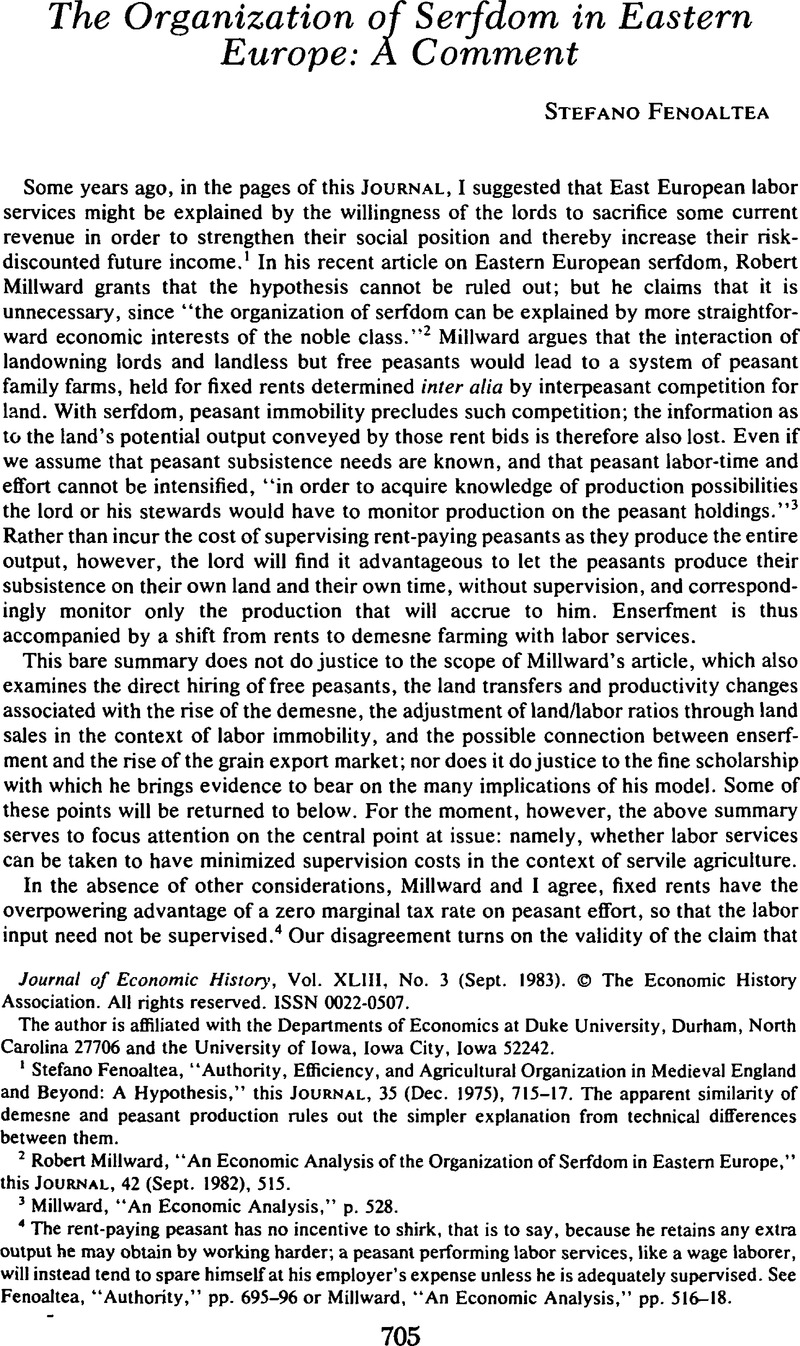Article contents
The Organization of Serfdom in Eastern Europe: A Comment
Published online by Cambridge University Press: 03 March 2009
Abstract

- Type
- Notes and Discussion
- Information
- Copyright
- Copyright © The Economic History Association 1983
References
1 Fenoaltea, Stefano, “Authority, Efficiency, and Agricultural Organization in Medieval England and Beyond: A Hypothesis,” this Journal, 35 (12 1975), 715–17. The apparent similarity of demesne and peasant production rules out the simpler explanation from technical differences between them.Google Scholar
2 Millward, Robert, “An Economic Analysis of the Organization of Serfdom in Eastern Europe,” this JOURNAL, 42 (09 1982), 515.Google Scholar
3 Millward, , “An Economic Analysis,” p. 528.Google Scholar
4 The rent-paying peasant has no incentive to shirk, that is to say, because he retains any extra output he may obtain by working harder; a peasant performing labor services, like a wage laborer, will instead tend to spare himself at his employer's expense unless he is adequately supervised.
See Fenoaltea, , “Authority,” pp. 695–96 or Millward, “An Economic Analysis,” pp. 516–18.Google Scholar
5 Millward, , “An Economic Analysis”, p. 526.Google Scholar
6 For simplicity, I am ignoring the random variability of agricultural output. In practice, clearly, any information-gathering experiment would need to be repeated over a period long enough to let those fluctuations average out. For the present experiment to obtain the desired result, moreover, the surplus-extracting rent should be set at the end of the experimental period of cultivation with an arbitrary rent; piecemeal adjustment would bias the experiment by revealing its purpose.
7 The lord would not abandon supervision, of course, if its purpose were not to gather information but to generate worker effort through the use of the lash. If this were the case, however, supervision would be maintained over all production, as in the case of the antebellum slave plantations, and one would not observe a division into peasant tenures and demesne. See Fenoaltea, Stefano, “The Slavery Debate: A Note from the Sidelines,” Explorations in Economic History, 18 (07 1981), 304–8, and “Slavery and Supervision in Comparative Perspective: A Model,” presented at the Cliometrics Conference, May 1980, Chicago.CrossRefGoogle Scholar
8 In the medieval West, the typical unfree peasant may always have owed a fixed rent rather than labor services; see Fenoaltea, , “Authority,” p. 697. The colonus of the late Roman period also appears to have been an immobile rent-paying peasant; but the possibility that the colonate was created by the state over the landowners' objections makes that experience less directly relevant to the issue at hand.Google Scholar
9 Millward, , “An Economic Analysis,” pp. 540, 543.Google Scholar
10 In both cases, it may be noted, the information is imperfect: the offer may be based on unreasonable expectations, and the attempt to extract the corresponding rent from the property may prove self-defeating. Offers to lease are clearer than offers to buy, since they avoid the problem of capitalizing future returns and therefore possible differences in discount rates. In the medieval West, the leasing of manors was a common phenomenon: see Fenoaltea, , “Authority,” p. 708.Google Scholar
11 Millward, , “An Economic Analysis,” p. 538.Google Scholar
12 Ibid., pp. 544–47.
13 For this reason, the “demand for men” characteristic of primitive feudal societies is better understood as a demand for surplus than a demand for peasants; see Fenoaltea, Stefano, “On a Marxian Model of Enclosures,” Journal of Development Economics, 3 (06 1976), 195–98.CrossRefGoogle Scholar
14 A more powerful argument would relate a redistribution of property rights in men to trade opportunities through the effect of the latter on the cost of, rather than the demand for, surplus. This effect occurs when the new imports are sophisticated weapons that alter the local balance of power. It would appear to have been significant, typically, when Europeans met technically less advanced civilizations; and it may be relevant to the case at hand. See Pettengill, John S., “The Impact of Military Technology on European Income Distribution,” Journal of Interdisciplinary History, 10 (Autumn 1979), 201–25.Google Scholar
- 3
- Cited by


